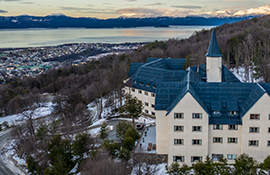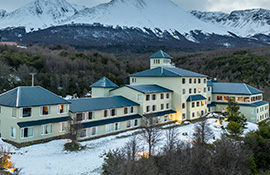USHUAIA
Ushuaia is the capital of the province of Tierra del Fuego, considered the southernmost of the world and is located on the north coast of the Beagle channel and at the bottom of the Martial mountain range, in the Cordillera de los Andes. Presents an irregular relief: glacial valleys, ancient peatlands, hills and hollows.
How to get there
By plane
The flights comes mostly from Buenos Aires, sometimes with stopover in Trelew, Río Gallegos or El Calafate and less frequently from Santiago de Chile, with a stopover in Punta Arenas. The companies that arrive at the island are Aerolineas Argentinas, LADE and LAN Chile, with fluctuating frequencies throughout the year. The island has two international airports. Flights arrive at the international airports of Rio Grande and Ushuaia (baptized Malvinas Argentinas). Both are very close to their respective cities and while there is no bus service, it won´t be expensive to take a taxi or remis transfer to the downtown of either cities.
By road
The Land route is a very good choice to visit Tierra del Fuego and go all over from north to south through the National Route 3, which is already fully paved in the province. The access roads are two: from the west, coming from Punta Arenas (Chile) or from the north, from Rio Gallegos (Santa Cruz Province, Argentina). In all cases you will cross, at least once, the frontier and the Strait of Magellan, which will give you the opportunity to observe the environment that surrounded the first explorers. To come from the north in particular, the means of arrival to the island of Tierra del Fuego are the same, ie coming from Punta Arenas, through the National Routes 255 and 257, whereas from Río Gallegos you will come by the National Route 3.
By sea
This path was the only possible - both to get to Ushuaia as Rio Grande - until mid-twentieth century, aboard ships coming from Punta Arenas or Buenos Aires bringing passengers and goods. However, currently there are no companies carrying passengers to Tierra del Fuego, unless it comes to Cruise Ship that sailed from various ports in the world, make a stop in Buenos Aires and offer itineraries organized with intermediate stops such as Mar del Plata, Puerto Madryn or Port Stanley (Falkland Islands). Although less frequent, sometimes arrives at the Port of Ushuaia antarctic ships with passengers who embarked on another port and, after his Antarctic visit, land in Tierra del Fuego.


The Climate
Regardless of the season, the time in Ushuaia tends to change from one day to another and even during the same day. In summer the average temperature for January is 9.6 ° C and the day with more daylight hours, reaches almost to 18. In autumn (unique in colors offered by the forest) and spring the weather is very unstable. The lowest temperatures are recorded in late July and early August, with an average of 1 ° C. In winter there are only from 7 to 8 hours of daylight but the days can be clear and bright. Between August and January winds grow in intensity.
Excursions
Currently, a few minutes from the city of Ushuaia and along Route No.3, eleven ski resorts concentrate in a few kilometers the fullest offer of winter activities of the country.
Ice skating, cross country skiing, snowmobiling, snowshoeing, downhill skiing, snowboarding, fascinating dog sled hiking and night tours are some of the options for living the full winter.
![]()
![]() Winter Resorts:
Winter Resorts:
Currently, a few minutes from the city of Ushuaia and along Route No.3, eleven ski resorts concentrate in a few kilometers the fullest offer of winter activities of the country. Ice skating, cross country skiing, snowmobiling, snowshoeing, downhill skiing, snowboarding, fascinating dog sled hiking and night tours are some of the options for living the full winter.
In the City:
![]()
![]() City Tour:
City Tour:
While crossing the city, the buildings, panoramic points and the most outstanding places of interest revealing myths and legends that make up the history of the southernmost city in the world since its early years. The most picturesque alternative is to ride in an old double decker bus (Classic Double Decker).
![]()
![]() Museo del Fin del Mundo:
Museo del Fin del Mundo:
Although the building dates from 1903, the Museo del Fin del Mundo opened in 1979 and since then has focused on the enhancement of the entire provincial heritage. Its collections are exhibited in five rooms, where stand showcases are dedicated to the Fuegians natives, explorers, personalities linked to local history, testimonies of ancient shipwrecks and natural history. It features an extensive library and boutique for visitors. Maritime Museum - former prison of Ushuaia.
![]()
![]() Martial glacier:
Martial glacier:
It is located about 7 kilometers from the city and is one of the favorite activities for visitors to enjoy the best view of the city. At the base there is a chairlift that go over 1200 mts., which is the lifting for the downhill track that works there in winter, while the rest of the year it is ideal for hiking.
After a twenty minutes chairlift, you can choose to continue climbing on foot doing a mountain hike, across sectors of high forest or stunted and tall vegetation to reach the base of the glacier. Throughout the journey, you can enjoy a beautiful panoramic view of the city, the Beagle Channel and the Chilean islands Navarino and Hoste.
In the area of the base of the chairlift, the mountain resort offers some additional services like canopy. Either during the day or in the night version, this fun activity allows visitors of all ages to experience the feeling of "flying" gliding through the treetops in the middle of the forest, along zip lines and suspension bridges, with the driving and the necessary security offered by the guides.
![]()
![]() Artisan's Lane:
Artisan's Lane:
The only craft fair in Ushuaia, the most varied and attractive range of genuine productions made by local artisans and visitors. Metals, silverware, textiles, wood, ceramics, paintings, leather and more.
![]()
![]() Maritime Museum Art Gallery:
Maritime Museum Art Gallery:
![]()
![]() Navigation through the Beagle Channel:
Navigation through the Beagle Channel:
From the port of Ushuaia depart daily different types of boats sailing the Beagle Channel, visiting the colonies of wild fauna and birds. The classic circuit available all year runs along the Bird Island and Isla de los Lobos, continuing to the emblem site of the city : the Lighthouse Les Eclaireurs, a symbol of "the end of the world" which actually means to mariners the entrance to the Bay of Ushuaia. The tour lasts two to four hours depending on the vessel type and may be performed in the morning or afternoon.
HOTEL
Check In
06
Feb
Check Out
07
Feb
Adults
2
Children
0
Hotels in Ushuaia

Las Hayas Ushuaia Resort

